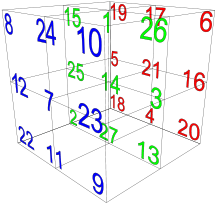Magic cube

In mathematics, a magic cube is the 3-dimensional equivalent of a magic square, that is, a number of integers arranged in a n × n × n pattern such that the sum of the numbers on each row, each column, each pillar and the four main space diagonals is equal to a single number, the so-called magic constant of the cube, denoted M3(n).[1] It can be shown that if a magic cube consists of the numbers 1, 2, ..., n3, then it has magic constant (sequence A027441 in the OEIS)
If, in addition, the numbers on every cross section diagonal also sum up to the cube's magic number, the cube is called a perfect magic cube; otherwise, it is called a semiperfect magic cube. The number n is called the order of the magic cube. If the sums of numbers on a magic cube's broken space diagonals also equal the cube's magic number, the cube is called a pandiagonal cube.
Alternate definition
In recent years, an alternate definition for the perfect magic cube has gradually come into use. It is based on the fact that a pandiagonal magic square has traditionally been called perfect, because all possible lines sum correctly. This is not the case with the above definition for the cube.
Multimagic cubes
As in the case of magic squares, a bimagic cube has the additional property of remaining a magic cube when all of the entries are squared, a trimagic cube remains a magic cube under both the operations of squaring the entries and of cubing the entries.[1] (Only two of these are known, as of 2005.) A tetramagic cube remains a magic cube when the entries are squared, cubed, or raised to the fourth power.
Magic cubes based on Dürer's and Gaudi Magic squares
A magic cube can be built with the constraint of a given magic square appearing on one of its faces Magic cube with the magic square of Dürer, and Magic cube with the magic square of Gaudi
See also
- Perfect magic cube
- Semiperfect magic cube
- Multimagic cube
- Magic hypercube
- Magic cube class
- Magic series
- Asymptotic magic hyper-tesseract
- Nasik magic hypercube
- John R. Hendricks
References
- 1 2 W., Weisstein, Eric. "Magic Cube". mathworld.wolfram.com. Retrieved 2016-12-04.
External links
- Harvey Heinz, All about Magic Cubes
- Marian Trenkler, Magic p-dimensional cubes
- Marian Trenkler, An algorithm for making magic cubes
- Marian Trenkler, On additive and multiplicative magic cubes
- Ali Skalli's magic squares and magic cubes